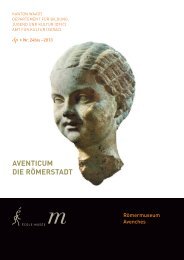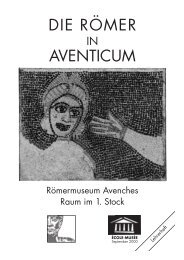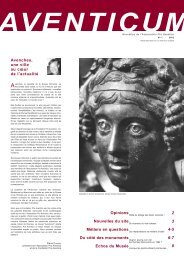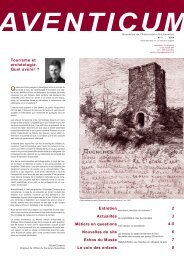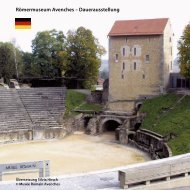Avenches – Roman Museum – Permanent Exhibition
Avenches – Roman Museum – Permanent Exhibition
Avenches – Roman Museum – Permanent Exhibition
You also want an ePaper? Increase the reach of your titles
YUMPU automatically turns print PDFs into web optimized ePapers that Google loves.
Second Floor Gardens<br />
There were various types of seats: stools, benches, chairs and armchairs,<br />
sometimes made more comfortable by adding cushions.<br />
The tables placed next to the dining room couches in Mediterranean style were<br />
round and low, while rectangular and high tables, around which one could sit,<br />
represent local custom.<br />
The couches, on which one lay down for meals, were often quite elaborately<br />
decorated with bronze or <strong>–</strong> less frequently <strong>–</strong> bone or ivory fittings and were covered<br />
with mattresses and cushions.<br />
For stowing away ones belongings, one mainly used different sizes of chests, which<br />
were often decorated. In certain houses precious objects or family archives were<br />
placed in a cupboard, the upper part of which could be used as a lararium (small<br />
house altar). Chests and cupboards were closed with locks, some of which had<br />
rather complicated mechanisms (no. 38).<br />
1-5. Bronze busts attached to furniture or doors.<br />
6. Bronze bust, decorating an armrest.<br />
7-12. Iron and bronze keys (2).<br />
13-14. Bolts from iron and bronze locks.<br />
15. Iron decorative element inlaid with gold and copper.<br />
16-18. Bronze handles.<br />
19. Box of silver-plated bronze lock with niello decoration.<br />
20-24. Bronze key rings.<br />
25-27. Bronze, iron and bone furniture hinges.<br />
28-32. Fragments with glass and bone inlay.<br />
33-35. Bronze nails with figurative heads.<br />
36. Bronze lock back plate.<br />
37. Bronze leg of a piece of furniture or a brazier.<br />
38. Lock with bronze and iron key.<br />
39-42. Ivory plates (copies).<br />
Gardens (3)<br />
A great number of the houses in Aventicum included a green space, for instance a<br />
vegetable patch or an ornamental garden. The latter were often situated where they<br />
could be enjoyed from the reception rooms. Decorated round discs (oscilla) (no. 1),<br />
which swung in the wind, were sometimes suspended between the columns of<br />
the portico surrounding the garden. Statues, fountains, stone benches and tables,<br />
water basins or arbours, which could be used as dining rooms in the summer, were<br />
all part of the usual fittings of these gardens. A variety of plants were used to form<br />
geometric patterns.<br />
1<br />
2<br />
3<br />
52<br />
Second Floor<br />
7



